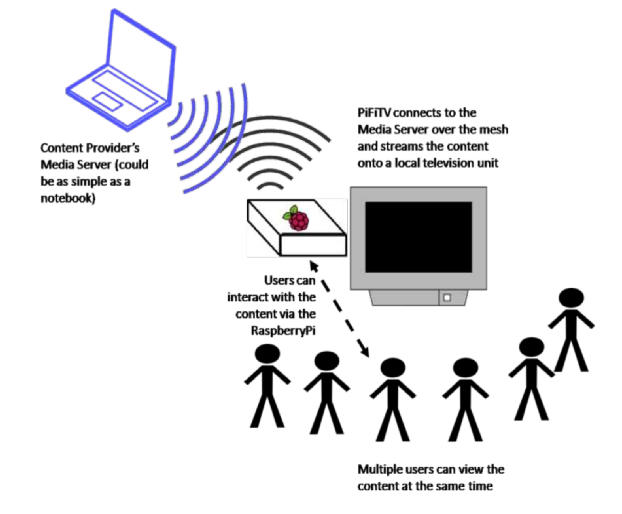Wi-Fi Mesh
Wi-Fi, (802.11b/g) is a d eregulated medium in most countries. Most internet users are familiar with Wi-Fi networks and most mobile devices today come equipped with an inbuilt Wi-Fi adapter. Typically Wi-Fi is set up in a hub-and-spoke configuration, where one Wi-Fi hub provides connectivity to many clients. The hub acts as a gateway to process all traffic on the network and in order to communicate with peers on the network a user must go through the gateway. This is analogous to the service provider model of communications and Wi-Fi has a strong use case as a means to share a single internet connection between multiple users.
eregulated medium in most countries. Most internet users are familiar with Wi-Fi networks and most mobile devices today come equipped with an inbuilt Wi-Fi adapter. Typically Wi-Fi is set up in a hub-and-spoke configuration, where one Wi-Fi hub provides connectivity to many clients. The hub acts as a gateway to process all traffic on the network and in order to communicate with peers on the network a user must go through the gateway. This is analogous to the service provider model of communications and Wi-Fi has a strong use case as a means to share a single internet connection between multiple users.
While Wi-Fi has predominantly been used as a means of last mile connectivity to service providers, most Wi-Fi enabled devices can also be used in peer to peer mode, i.e. to communicate directly with other devices, without the intervention of a service provider or gateway. This ability can be used to build a peer to peer based network topology called a mesh. A mesh network is different from a hub-and-spoke network in that there can be many paths between two points on the network. As a result, members of a mesh network share a peer or peer-like relationship.
The Internet itself is a mesh of meshes as it does not depend on any single service provider and service providers become peers from the point of view of the internet. Reducing costs of Wi-Fi equipment and new developments in networking software have made it possible to build low cost, community owned and operated mesh networks and lately this form of network is becoming a popular alternative to the cloud, particularly for low income and rural communities Multiple meshes can be connected to each other and to the internet in innovative ways such as physical transfer of bulk data (Data Muling) and by pooling low bandwidth connections available on the mesh.
RaspberryPi
The RaspberryPi is a USD35 single board computer. The Pi comes with 512 MB of RAM and a 1GHz processor, making it comparable in performance to a netbook or a cheap desktop computer.
The Pi is more than adequate for
- Basic web browsing
- Multimedia Access
- Basic Knowledge processing tasks
The Pi can use an HDMI or S-Video interface for a display, meaning that it can even be connected to old CRT based TV sets, which are quite popular in rural and urban low income households. With a USB Wi-Fi adapter and a keyboard, the Pi can convert any TV into a PiFiTV
Components and interactions on the PiFiTV network
The following components and interactions are possible in a community owned wireless mesh scenario


PiFiTV Features
The PiFiTV model holds the possibility of putting even rural and low income user groups at par with users of high end interactive television. PiFiTV can use even basic CRT based television sets over the S-Video channel besides supporting newer high definition TVs via HDMI. Moreover, the RaspberryPi is a low power device (5V, 1A) and can even be powered with a cheap solar panel, adding almost no extra cost to the household’s power budget. The addition of a simple wireless mouse makes the Pi a two way interaction device, where users can not only select the program they want to watch but also interact with it if the content is so designed. With a battery operated speaker, can be used as a Wi-Fi radio during power cuts. We are currently exploring the feasibility of using low power display devices such as pico projectors as well. From a provider standpoint, the PiFiTV model is similar to the local cable operator model recently phased out by digital cable, combined with the possibility of multiple content providers on the same network. This means significantly lower content hosting and dissemination costs for providers since the underlying network is relatively small scale, community owned and entails a lower over-all cost of operation. In fact any provider can join the network as a peer and host content by simply operating or sponsoring the operation of some member devices.
Collaboration
We are very keen to partner with content providers such as independent artists, writers, bloggers, performers and other interested parties who are keen to acquire a user segment in areas beyond the pale of connectivity Partners are welcome to engage with us by
- Wholly or partly supporting community Wi-Fi network build outs in low/no connectivity areas
- Providing content for delivery on Wi-Fi networks that we are already setting up through one of our existing partners
- Visiting the deployment zone and conducting agenda/content specific workshops that have a clear follow on the network
- We are also open to other interesting ideas for collaboration
Proof of Concept
We are working on a project in collaboration with Janastu हैकरgram to build and test a Community Owned Wi-Fi mesh network connecting 5 villages in the Devarayanadurga area in Karnataka. The project is called COWDev and is supported by the Open Technology Fund. The region is interesting as it has a large underserved population in terms of connectivity, owing to its position inside a forest reserve where getting permissions to set up cell phone towers is hard. We are keen to focus on women and young people as primary users and operators of this network PiFiTV is one of the key services we will be piloting on this network.
The initial PiFiTV demo system is set up at the residence of Renu and Mukunda Rao ji of Janastu, who have been living among the community in Hale Kote (one of the villages in the region) for a number of years. Janastu is the host organization and community connect partner for हैकरgram at Hale Kote.




 The Mojolab Foundation is very happy to announce the PeopleTech Internships in  partnership  with
The Mojolab Foundation is very happy to announce the PeopleTech Internships in  partnership  with